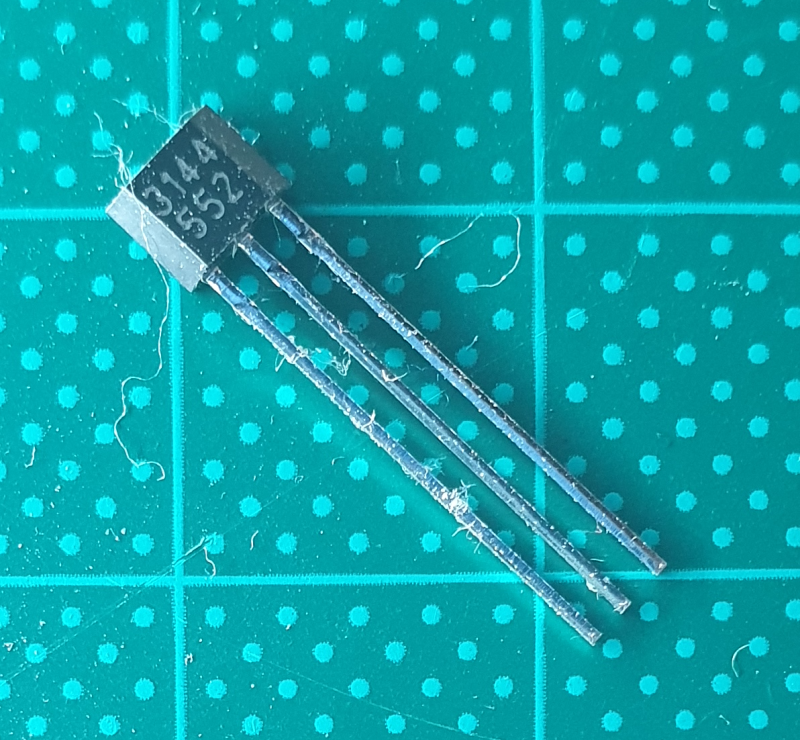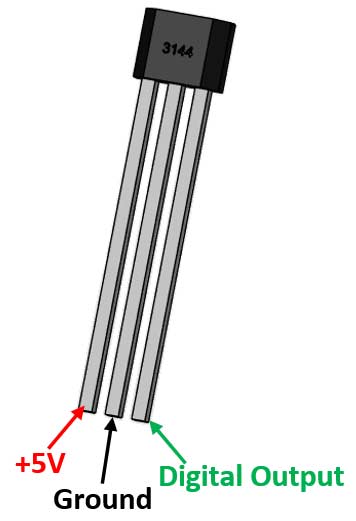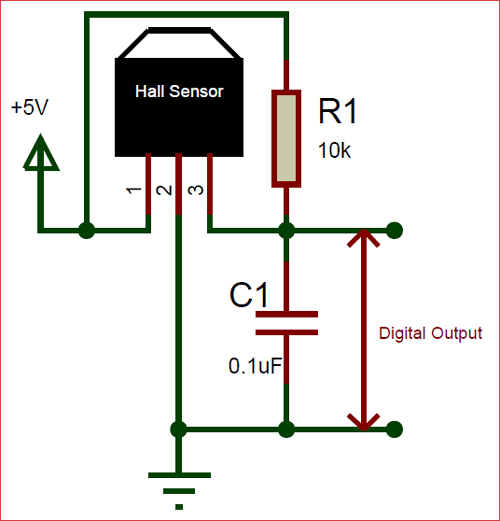|
|
Active components, Sensor, Hall sensor
Magnets are intrinsic to Hall effect sensors, which are activated by the presence of an external magnetic field. The device is then able to sense as an object moves either closer or further away, just through the differing strengths of the magnetic field.
All magnetic fields have two important characteristics. Firstly, what is called a ‘flux density’, which refers to the the amount of magnetic flow passing through a unit area, and secondly, all magnets feature two polarities (the North and South poles).
The output signal that comes out from a Hall effect sensor represents the density of a magnetic field around the device. Hall effect sensors have a preset threshold, and when the magnetic flux density exceeds this limit, the device is able to detect the magnetic field by generating an output called the ‘Hall Voltage’.
Hall effect sensors all have a thin piece of semiconductor material inside them, which passes a continuous electrical current through itself to generate a magnetic field. When the device is placed near an external magnet, the magnetic flux exerts a force on the semiconductor material.
This force causes a movement of electrons, creating a measurable Hall voltage and activating the Hall effect sensor.
The output Hall voltage from the Hall effect sensor is directly proportional to the strength of the magnetic field passing through the semiconductor material. Often, this output voltage is quite small - equal to only a few microvolts - with many Hall effect devices including built-in DC amplifiers, alongside logic-switching circuits and voltage regulators, which are there to help improve the sensitivity (and therefore effectiveness) of the device.
Hall effect sensor types
There are two types of Hall effect sensors: Devices with linear (or analogue) outputs, and those that have digital outputs. Analogue sensors use a continuous voltage output that increases within a strong magnetic field and decreases in a weaker field.
With linear output Hall effect sensors, as the strength of the external magnetic field increases as the device comes into contact with the magnet, the output signal increases in parallel until it reaches the limits imposed by the power supply.
The digital output device, conversely, has a ‘Schmitt trigger’, which is a bistable circuit that steadily increases and decreases the output when the voltage rises and falls to different thresholds.
Thanks to the Schmitt trigger, when the magnetic flux passing through the Hall effect sensor exceeds the device’s preset value, the output from the device switches it from ‘off’ to ‘on’. As the sensor then moves in and out of the magnetic field, the built-in hysteresis in the device eliminates any oscillation of the output signal.
There are two types of digital Hall effect sensors: bipolar and unipolar, which differ depending on the type of magnetic field needed to operate them.
Bipolar digital Hall effect sensors need a positive magnetic field (which comes from the South pole of a magnet) to operate them, and use the negative field (from the North pole) to release them. Unipolar sensors only need a single magnetic South pole to both operate and release them as they move in and out of the magnetic field.
As the output drive capabilities are very small on the majority of digital Hall effect sensors, most of these devices cannot directly switch large electrical loads. Many digital sensors counter this by using an open-collector NPN transistor.
The transistor operates as a switch, shorting out the output terminal to the ground when the magnetic flux density is higher than the Hall effect sensor ‘on’ point. There are a wide range of Hall effect switches available, which are suitable for a variety of different tasks.

 Hall-effect sensor Specifications
Hall-effect sensor Specifications
- Digital Output Hall-effect sensor
- Operating voltage: 4.5V to 28V (typically 5V)
- Output Current: 25mA
- Can be used to detect both the poles of a magnet
- Output voltage is equal to operating voltage
- Operating temperature: -40°C to 85°C
- Turn on and Turn off time is 2uS each
- Inbuilt reverse polarity protection
- Suitable for Automotive and Industrial Applications
A3144 is a digital output hall sensor, meaning if it detects a magnet the output will go low else the output will remain high. It is also mandatory to use a pull-up resistor as shown below to keep the output high when no magnet is detected.

HALL-EFFECT SENSOR ANALOG 49E
- 3,5V tot 24V gelijkspanning bedrijfsspanning
- Laag stroomverbruik
- Temperatuur compensatie
- Groot werkspanningsbereik
- Open-Collector pre-stuurprogramma
- 50mA maximale zinkuitgangsstroom
- Bescherming tegen omgekeerde polariteit
Een Hall-effectvergrendeling werkt als een schakelaar. Hij vergrendelt wanneer de magneet in de buurt van de sensor is (zuidpool). Het wordt uitgeschakeld als de tegenovergestelde magneetpool (noordpool) wordt toegepast.
The 49E sensor can detect both the North and South pole of a magnet as well as the relative strength of the magnetic field. The side of the sensor with the labeling is the side used for detection.
Power Supply
The sensor can operate over a Vcc range of 2.3-10V.
If the output is being read by an MCU, it is advisable to operate the sensor at the same voltage as the MCU so that the sensor output will be compatible with the range of the analog input.
The power draw is stated as 4mA nominal but it will vary with Vcc. At 3.3V it draws 5mA and at 5V, it draws 7.8mA. It is possible to power the device off a MCU digital output pin.
Analog Output
The sensor output is an analog voltage. When no magnetic field is detected, the output will rest at approximately 1/2 Vcc. If the south pole of the magnet is brought near, the output will linearly ramp towards Vcc and if the north pole of the magnet is brought near, the output will linearly ramp towards ground.
In the case of Vcc being 5V, with no magnetic field present the output will rest at about 2.5V. If the south pole of the magnet is brought near, the output will raise linearly up to a maximum of about 4.2V. If the north pole is brought near, the output will lower linearly to a minimum of about 1.0V.
The output is typically read by an ADC port on a uC if the strength or pole of the magnetic field is important. Optionally it can be run into a comparator like the LM393 if a digital output with an adjustable set-point is desired. If you are just counting the number of times a magnet goes by, this is easier than working with the analog output. Digital Hall-effect sensors are also available for this purpose.
/*
Analog 49E Hall Effect sensor test
Basic code for reading the analog output of the 49E hall effect sensor.
Sensor is connected to A0, but can be any analog input pin.
*/
const int AnalogPin = A0;
const float GAUSS_PER_STEP = 2.57; // Sensor outputs approx 1.9mV / Gauss.
// ADC step is about 4.89mV / Step for 5V operation.
float rawValue = 0.0; // Raw ADC Reading
float gaussValue = 0.0;
float zeroLevel = 518.0; // Adjust value as needed to get zero rawValue output with no magnetic field.
//===============================================================================
// Initialization
//===============================================================================
void setup()
{
pinMode (AnalogPin, INPUT);
Serial.begin(9600); // Set comm speed for debug window messages
}
//===============================================================================
// Main
//===============================================================================
void loop()
{
rawValue = analogRead (AnalogPin) - zeroLevel; // Output normalized to '0' with no field present
Serial.print ("Reading Raw: ");
Serial.println (rawValue);
// Reading positive relative to the South Pole, the North Pole negative
gaussValue = rawValue * GAUSS_PER_STEP;
Serial.print ("Reading in Gauss: ");
Serial.println (gaussValue);
delay (3000);
}

3144, #200, Bak 7.03.A (Digital Output if it detects a magnet the output will go low else the output will remain high)
41F, #10, Bak 7.03.B
49E, #30, Bak 7.03.B
95A, #10, Bak 7.03.B
A02K, #10, Bak 7.03.B
OH137, #5, Bak 7.03.B
U18, #10, Bak 7.03.B
Alternative Digital Hall-effect Sensors
A3141, A3142, A3143, US1881, OH090U
Other Analog Hall-effect Sensors
A1321, A1302, SS495B, ASC712
Source:https://components101.com/sensors/a3144-hall-effect-sensor
|